|
1.
Wadi Mujib’s lower gorge
“The
view which the Mujib represents is very striking… the valley looks
like a deep chasm formed by some convulsion of the earth, into which
there seems no possibility of descending to the bottom.” (J. L. Burckhardt,
1812)
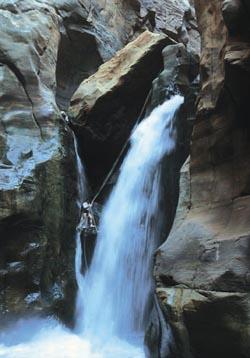
Wadi
Mujib's waterfall (Itai Haviv)
Experiencing
Jordan’s Grand Canyon involves swimming, jumping, abseiling and floating.
Seen from its bottom, its sheer red walls tower skyward while its all
width is filled with running water, plunging through an awe-inspiring
15 m waterfall.
Beautiful
pools are located near the confluence of Wadi Mujib and Wadi el Hidan,
tempting the trekker to swim against the current into the majestic gorge
of Wadi el Hidan.
Entrance
fees to this trail are 20 JD. They are payable at the RSCN shed beneath
the Mujib Bridge. It is advisable to book in advance, as the number
of visitors per day is limited.
Type
of route:
Circular.
Altitude difference, Distance and Walking time: 200 m ascent
and descent with some level stretches in between, 6 km, 9 hours.
Rating: Strenuous. Abseiling is unavoidable. The route
includes swimming sections.
Falls: One waterfall. A few sections where hiker’s rope is
necessary.
Special equipment: Two 20 m ropes and ordinary abseiling gear.
Unless you have a waterproof bag everything you carry will get wet.
Guides: An RSCN guide is compulsory.
Water: Gushing stream. The water is not recommended for drinking.
Consider carrying 3 liters each.
Season: The Mujib gorge is open from the 1st of
April to the 31st of October. Be aware of flash flood risk
even during this period! The route is most enjoyable in mid-summer.
Getting
there and back: From er-Rama junction , drive south along the
Dead Sea road, cross the Mujib Bridge and proceed for another 2 km.
The trail starts where a little wadi descends towards the road, near
a clump of tamarisk trees and a signpost of the Mujib Nature Reserve.
The route ends at the Mujib Bridge. Make arrangements to be picked
up, or you will have to hitchhike back to er-Rama or Mazra‘a junctions.
Ascend
along the right side of the little wadi, following a ruined track to
reach a T junction after about 20 minutes. Turn left, descending past
the campsite of the reserve before climbing steeply once again. It takes
about 50 minutes to reach the top of the ascent.
Before
you descend into Wadi Mujib, climb to one of the light-colored marl
mounds for a comprehensive vista. The Dead Sea expands below with the
escarpment of the Judean Desert rising above its opposite shore. At
the foot of the escarpment lies the settlement of ‘Ein Gedi, famous
as an oasis and a subtropical nature reserve.
Looking
east, it is easy to spot the course of Wadi Mujib but it is almost impossible
to locate its outlet. A closer look reveals that the most natural outlet
is through the valley from which you ascended. The valley, however,
seems to be “blocked” with light colored marl layers, which were deposited
at the bottom of the Dead Sea at a period when its level was much higher.
During
the last Ice Age the water level of the Dead Sea reached 180 m below
sea level, about 230 m higher than today. The lake flooded the lower
reaches of the canyons along its banks, which became bays and begun
to accumulate sediments. As the climatic conditions changed, about 20,000
years ago, the water level of the lake dropped, leaving the re-emergent
canyons blocked with lake marl. Most canyons managed to cut through
their plugged outlets and to resume their erstwhile lower courses. However,
Wadi Mujib abandoned its former outlet by breaking through a cleft in
the sandstone. This narrow cleft became the bottleneck of an enormously
large drainage basin with a huge discharge. During the years the cleft
was scoured deeper and the gorge of Wadi Mujib was formed.
Leaving
the lookout point, descend along the track to reach the wadi bed within
20 minutes. The impressive gate of the Mujib gorge can be seen to the
left, but before venturing into the gorge proceed upstream for 30 minutes
towards the confluence of Wadi Mujib and Wadi el Hidan. Walking in the
water among reeds and oleanders, turn left at the confluence. Advance
along boulders on the left-hand side of the wadi, arriving soon at a
beautiful pool. Just above the pool is a rocky platform, convenient
as a base for further exploration.
Beyond
the pool begins the majestic gorge of Wadi el Hidan. Its smooth sandstone
walls curve upwards while sparkling water fills its whole width. Leaving
your gear behind, you can swim into the gorge and even cross a few cascades
before a gushing low waterfall blocks your way. It is a magical place.
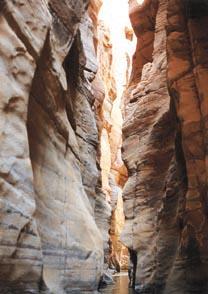
Wadi
Mujib's lower gorge (Shai Reuveni)
Retrace
your steps downstream to reach the entrance to the lower gorge of Wadi
Mujib. Put valuables in a waterproof bag before progressing. Water level
in the gorge may be waist-high and there are sections where you have
to swim. Descending the Mujib gorge is an awe-inspiring experience.
Its sheer walls are so close and so high that the sky is seen as a mere
blue ribbon between the red rims. Bypassing a pile of boulders from
the right, you reach the breathtaking Mujib waterfall about 40 minutes
from the head of the gorge. Its gushing waters drop 15 m into a pool
surrounded by vertical walls. The only way down is by abseiling.
Once
beneath the waterfall, a demanding section is still ahead. Stick to
the right side of the gorge, descending a vertical drop using a short
rope. Soon afterwards, return to the middle of the gorge and slide down
a smooth boulder. Another giant boulder lies just ahead. Hold on to
a rope and slide to the edge of the boulder towards a 2 m drop into
a shallow pool. A turbulent pool is a few minutes ahead - take care!
The final section towards the outlet is a peaceful journey with no serious
obstacles. The Mujib Bridge is reached some 90 minutes from the waterfall.
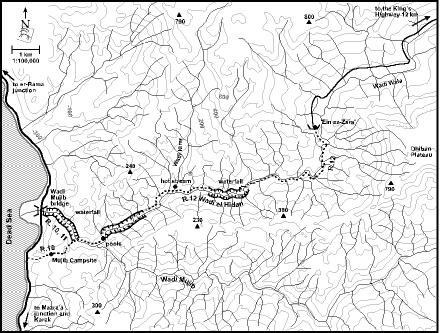
The
Mujib Nature Reserve
2.
Jabel Baqer
“"Nothing
could be more beautiful than the Gulf of 'Aqaba, gleaming through
its fringe of palm-trees, as we left the fort, like a placid lake
- an eye, rather, of the deepest blue, eye-lashed with palms, and
eye-lidded with the Arabian mountains." (Lord Lindsay, 1837)
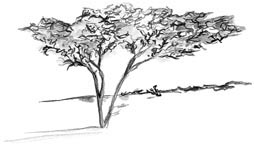
Acacia
tree
For
magnificent views over the Gulf of 'Aqaba and the 'Araba Valley, no
other peak in the area can compete with Jabel Baqer. Towering to 1590
m, this lofty granite mountain overlooks Jordan, Egypt, Saudi Arabia
and Israel. Just be there!
Type
of route: One-way and back.
Altitude difference, Distance and Walking time: 700 m ascent
and descent, 6 km, 6 hours.
Rating: Moderate.
Special equipment: None.
Guides: Might help. Try the Bedouin which encamp at the entrance
to Wadi Mizfar.
Water: None. Consider carrying 3 liters each.
Season: Year-round. Avoid hot summer days. Visibility is usually
at its best straight after a rainy day.
Getting there and back: A high-clearance vehicle is needed in
order to approach the mountain. You can find a pickup truck in 'Aqaba
(in the fruit market), Quweira or Rashidiya depending on the direction
you are coming from. The approach to the mountain starts at Wadi Mizfar,
which is crossed by the Amman-'Aqaba road 8 km north of Wadi Yutm junction
and 19 km south of the junction to Wadi Rum. (About 1 km south of the
Wadi Mizfar is the resthouse el Istiraha el Faranciya, used mostly by
truck drivers)
Turn west toward white buildings on the north bank of Wadi Mizfar. Passing
the buildings, descend into the actual bed and continue west to reach
a fork, 4 km from the road. Take left at the fork towards a tin hut
built on a concrete base. Make arrangements to be picked up from the
same place.
Leaving
the tin hut climb south along a side wadi, which leads towards the obvious
saddle of Jabel Baqer. Within about 30 minutes, a cluster of palm trees
is seen to the left. Above the palms is a deserted agricultural terrace,
where pomegranate and grapevine were once cultivated. Another 40 minutes
will take you to the saddle (1,280 m), from where you see the railroad
to 'Aqaba winding through Wadi Yutm. The pile of stones is probably
a ruined leopard trap.
To reach the summit, adhere to the north face of the mountain, slogging
over granite croppings without a clear trail. Along the way are many
resting patches of ibex, as well as a few juniper trees, which manage
to thrive between the pink boulders. The summit is reached within about
45 minutes from the saddle. Should you fancy to spend the night at the
mountain top, it offers a few level patches, beside a spectacular panorama
of views.
Three neighboring countries are seen from the summit: Saudi Arabia far
to the south, Egypt to the southwest and Israel to the west. The 'Araba
Valley and the Gulf of 'Aqaba yawn at your feet. 'Aqaba and its twin
city Eilat share the northern tip of the Gulf. The most prominent among
the mountains of Eilat is Mount Solomon, which rises darkly just behind
the city. Further to the north is the flat-topped Mount Timna', similarly
hued, looming above its ancient copper valley. The equivalent mines
in Jordan are located 105 km to the north at Feinan. The difference
in latitudes is the result of the tectonic displacement along the Dead
Sea Rift.
Toward the southwest, one can follow the coastline of the Sinai Peninsula,
with a string of world-famous diving resorts. The mountains of Sinai
rise almost straight from the shore, towering to the highest altitudes
at the southwestern horizon. Visibility permitting, it may be possible
to identify Jabel Katharina (2,644 m) the highest peak in Sinai, and
in the entire region.
The landscape to the south is dominated by countless granite peaks,
veined through by dykes. On the east, behind a dark ridge, rise Jabel
Rum (1,754 m) and Jabel Umm 'Ishrin (1,753 m). These summits are the
second highest in Jordan. North of these stretches a vast flat area,
which ends at the escarpment of Ras en-Naqb.
Retrace your steps to the foot of the mountain. The way back takes about
two hours.
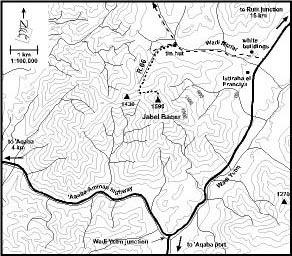
Jabel
Baqer
Additional
66 routes are available in the guidebook
'Trekking and Canyoning in the Jordanian Dead Sea Rift'
Top of the page
|